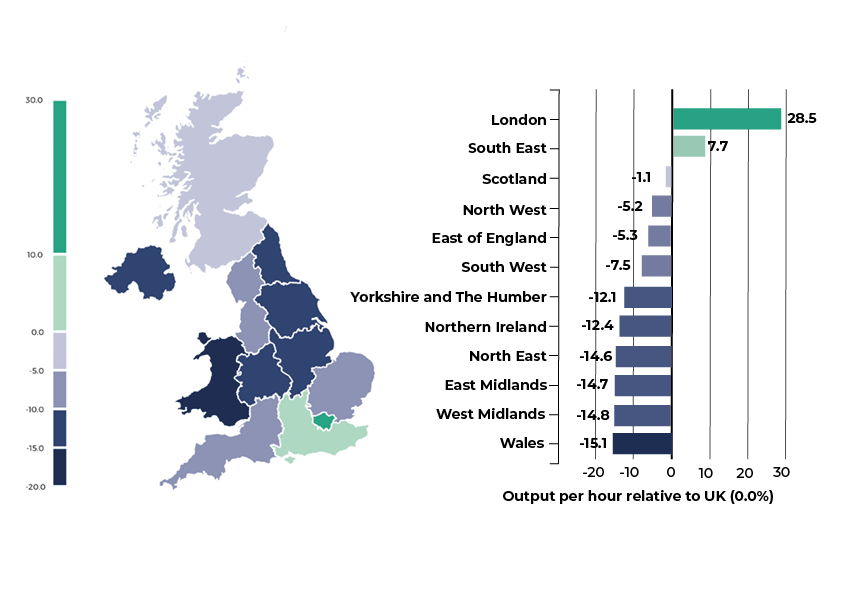In his book, ‘The Age of Diminished Expectations’, the Nobel prize winning economist, Paul Krugman said:
Productivity isn’t everything, but in the long run it is almost everything.
But what is productivity, why is it so important and how it is measured?
With the Senedd’s Finance Committee considering this week productivity in Wales in the context of its scrutiny of the Welsh Government’s Draft Budget 2026-27, in this article we seek to answer those questions. We’ve also published today a research briefing on productivity.
What is productivity and why is it important?
In September 2025, the Institute for Fiscal Studies (‘IFS’) said:
Productivity captures the relationship between the outputs or outcomes of a system and the inputs that system uses... Broadly, a system becomes more productive if it can produce more or better output or outcomes from the same level of inputs or if the same level of outputs or outcomes can be produced with a lower level of inputs.
Productivity growth leads to an increase in profits, enables increased employment and investment, as well as supports higher tax revenues and improved public service delivery, says the Wales Productivity Forum.
The International Monetary Fund notes:
Productivity is a foundation of prosperity. The only way a country can raise its standard of living sustainably is to produce more with existing or fewer resources. You cannot do that without improving productivity. It’s that simple.
The majority of the Welsh Government’s funding comes from a block grant from the UK Government. Professor Melanie Jones, Professor of Economics at Cardiff University and Academic Lead for the Wales Productivity Forum says this means Wales’ fiscal position is “heavily influenced” by UK productivity, which has been “a key constraint on the UK budget”.
The UK’s productivity is currently a hot topic with speculation about the Office for Budget Responsibility (‘OBR’) downgrading its forecasts for UK productivity and the impact this could have on the UK Government’s Autumn Budget (26 November 2025).
How is productivity measured?
Productivity, says the Association of Chartered Certified Accountants (‘ACCA’), is a “complex issue”. It identifies “labour productivity” and “Total factor productivity” (‘TFP’) as “Two of the best-known” standard measures of it.
Labour productivity can be measured by output (such as, gross value added (‘GVA’)) per unit of labour (for example, per worker or hour).
The Welsh Government uses GVA per hour relative to the UK average as one of its 50 National Well-being Indicators (number 9).
The ACCA says Total factor productivity (or ‘TFP’) “takes into account that outputs are produced using a combination of labour and capital inputs. To measure TFP, the total volume of outputs is divided by the volume of inputs….Increases in TFP reflect gains in output that are not due to rising inputs, eg technological improvements, more efficient financial systems etc”.
The UK’s ‘productivity puzzle’
Historically, productivity has tended to increase over time with more goods and services produced per hour worked, allowing living standards to rise.
However, productivity in the UK “fell sharply” at the peak of the Global Financial Crisis (‘GFC’) in 2008 and 2009. Since then, a former External Monetary Policy Committee Member at the Bank of England explained, the UK’s “productivity has been growing, but at a rate significantly lower than its pre-crisis trend rate”. This is commonly referred to as the “productivity puzzle”.
While productivity in other advanced economies has also slowed, the reduction has been “particularly sharp” in the UK, according to HM Treasury. It notes, in the decade prior to the GFC, the UK’s average productivity growth rate (in this case, measured by a component of Gross Domestic Product (‘GDP’) per capita growth) was around 2.1%. HM Treasury says this was higher than that in Germany and France, and only slightly lower than that of the US. However, in the ten years after the GFC, the UK’s average rate of productivity growth was 0.6%, compared to 1.2% in Germany and 0.9% in both France and the US.
What do the measures tell us about productivity in Wales?
The Office for National Statistics’ (‘ONS’) latest annual productivity data for UK regions relates to 2023 (published June 2025). This shows output (measured by GVA per hour) was the lowest in Wales of all the UK regions, at 15.1% below the UK average. This is shown below.

Source: Office for National Statistics’ Regional and subregional labour productivity, UK: 2023, (published June 2025) [Accessed 4 November 2025]
While remaining the lowest of all UK regions, the productivity data for 2023 showed an improvement on 2022 when output per hour in Wales was 17.3% below the UK average.
The ONS data also showed a cumulative average annual growth rate from 2019 to 2023 of 0.2% for Wales. This compares with 0.3% for Scotland and 1.8% for Northern Ireland. The UK’s average productivity increased by 0.7% over that period.
Professor Melanie Jones notes the picture varies across Wales, “with productivity in areas such as Powys, Gwynedd and Conwy and Denbighshire among the lowest in the UK”.
In its notes to its measures of regional productivity, the ONS cautions users that “volatility in the data will tend to increase as the geography gets smaller”. It also highlights additional caution relating to the declining sample sizes from the Annual Population Survey (‘APS’) 2023, which it uses for “some selected aspects of the productivity jobs and productivity hours calculations”. Also, the APS is due to be re-weighted to match the Census 2021 population.
The Office for Statistics Regulation (‘OSR’) has suspended the accredited official statistics status for the estimates ONS produces from the APS.
However, the ONS notes the APS is not the main source for the labour inputs used in its annual regional productivity data. Labour inputs come from the Labour Force Survey (‘LFS’).
In October 2025, the Resolution Foundation noted:
…the official data on the growth in hours worked are wrong. They come from the Labour Force Survey (LFS), which has been plagued with a small and biased sample, especially since the pandemic. Happily, those problems are being fixed, and we think that the LFS is now broadly accurate when it comes to the number of people in work … But the data wasn’t right a year ago, and this means we can’t trust the LFS when it says that employment has been rising strongly over the past year.
“Correcting for mismeasured labour inputs,” says the Resolution Foundation, “recent [UK] productivity growth has been strong”.
Where to find out more about productivity
Our research briefing about productivity includes information about public sector productivity, which has been of interest to the Finance Committee during its scrutiny, over recent years, of the Welsh Government’s budgets. The Finance Committee is currently scrutinising the Welsh Government’s Draft Budget for 2026-27. On 20 November, it is holding evidence sessions about productivity. You can watch these on Senedd tv.
Article by Joanne McCarthy, Helen Jones and Josh Jenkins, Senedd Research, Welsh Parliament






